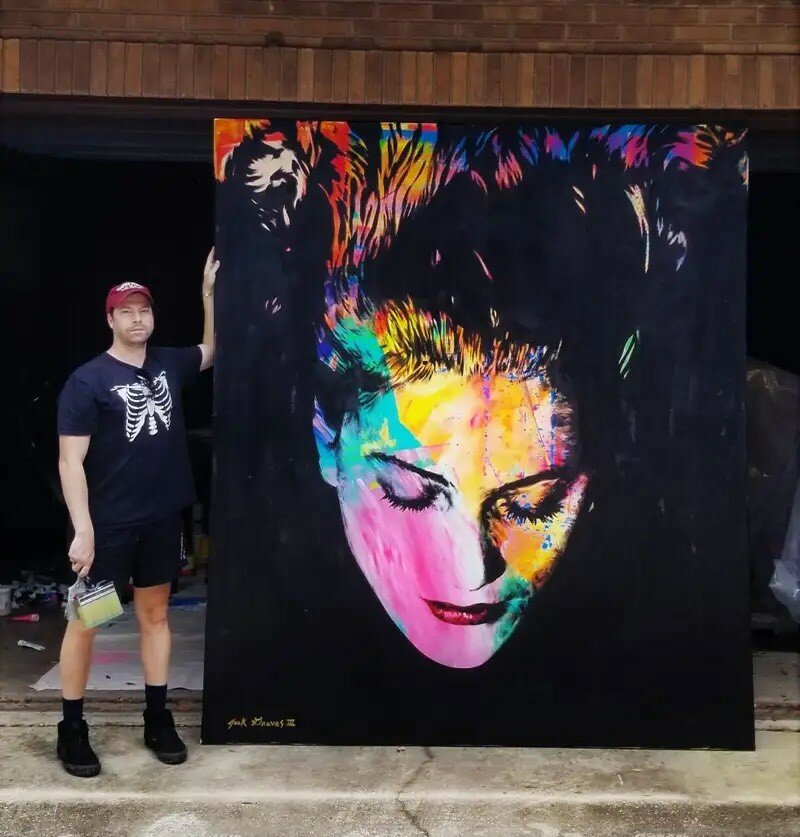Artist credits childhood in gallery for career
Artist Jack Graves III is on a journey of discovery. His art tends to grow organically in what he describes as visual poetry or, for the viewer, a kind of Rorschach image.
“I think there are three different ways of creating a work, and the least beneficial is when you actually map something out and try to construct it,” he said. “It kind of always turns out to be a horse by committee.”
He’s found that the best work begins with one or two ideas and grows from there.
“It’s creating a feeling and a seeing of these things that you wouldn’t have originally thought went together,” he said, “but once it’s there, it just leads you toward finding out that — at least within the definition of art — it does work.”
He said one of the biggest payoffs comes when he is done with the work, looks at it and says, “So that’s what that would look like!”
Graves grew up around art of every kind. His father, John Graves, is founder and owner of Graves International Art. Without having had that experience, Jack Graves said he probably would not have pursued art as a career.
“It was made tangible and accessible to me young enough that I was hard-headed enough to believe it was possible,” he said.
Otherwise, he might have turned his talents in a different direction.
“I’d have been one of these people that would have used the talent of artistry within a profession and then found time to paint as a hobby when I’m 55 or something,” he said.
As a child, he enjoyed drawing, and was intrigued by visual things.
“If you’re looking at African sculpture compared with a Warhol Mick Jagger print compared to a Japanese woodblock, it’s like all three of those give you a definite feeling, and they’re all different,” he said. “Growing up around all that was huge.”
Another unexpected influence arrived when he was in boarding school. A fellow student from Japan left a pen in his dorm room, but it wasn’t just any pen. It was an incredibly fine utensil made by Mitsubishi. This happened about the time Graves was drawing a lot of elaborate, detailed designs on paper. The ink appealed to him because, as a youth, he had a penchant for black.
“They thought I was colorblind all through elementary school,” he said, laughing. “They were like, ‘He only ever uses a black crayon.’ But I thought it was cool.”
He calls these early ink pieces the cornerstone of all his work. It definitely illustrates his exploration of the evolving image.
“I knew if I started in the corner and covered a whole page in disciplined design, and continued to make it more and more disciplined and ornate — you can’t not call that art,” he said.
Those works, so reliant on the line, prefigure his later use of imagery and color. What these elements offer is an ongoing source of discovery.
“You want the piece to continuously live,” he said. “You’re always coming back and finding something new, or always finding something invigorating or pleasing about this.”
Graves is known for his many series, which came about as the result of his dislike of monotony. When he begins a series he must first be sure his interest will sustain him through at least 50 to 100 entries.
The Aura Series consists of a variety of concentric circles, where the width and color of each evokes a feeling.
“I definitely wanted to create kind of this floating reverberation with the viewer,” he explained.
Determining the number of circles in a given work relies on a kind of sensibility he has. He compared this to finding that point on a spirit level when the bubble is centered. Likewise, he “sees” the best color for that circle.
His Diamond Series plays with color, placement and variations, and it is interesting to compare one piece with another.
His Icon Series largely features the faces of famous people, typically using the black line and then playing with the coloring. He compares his earliest pieces in this series to the work of Jackson Pollock. Later, he moved increasingly toward more realistic images, somewhat reminiscent of the work of Roy Fox Lichtenstein. In his most recent icons — most notably images of Doutzen Kroes, Cara Delevinge and Kate Moss — the size of the face in relationship to the canvas, as well as its placement, contribute to a refinement of entries in this series.
His most recent Female Face Icons return to the power of the line, what is essential to elicit what Graves calls Plato’s concept of the ideal.
“I’m like: Let’s think about a female face; let’s see what I subconsciously think about where the chin goes, where the eyes go,” he said. “And then, how few lines I really need to do that.”
Viewing these pieces, one is reminded of some of Matisse’s line drawings.
Graves has also experimented with sculpture and has created several notable murals, most during his time in Charlottesville, Virginia.
“I’m just fortunate and happy that I can do this for a living,” he said.
Learn more about Graves and his work at gravesinternationalart.com and jackgravesiii.com.
Read about how Graves' father built a business in the art world. Click HERE.







